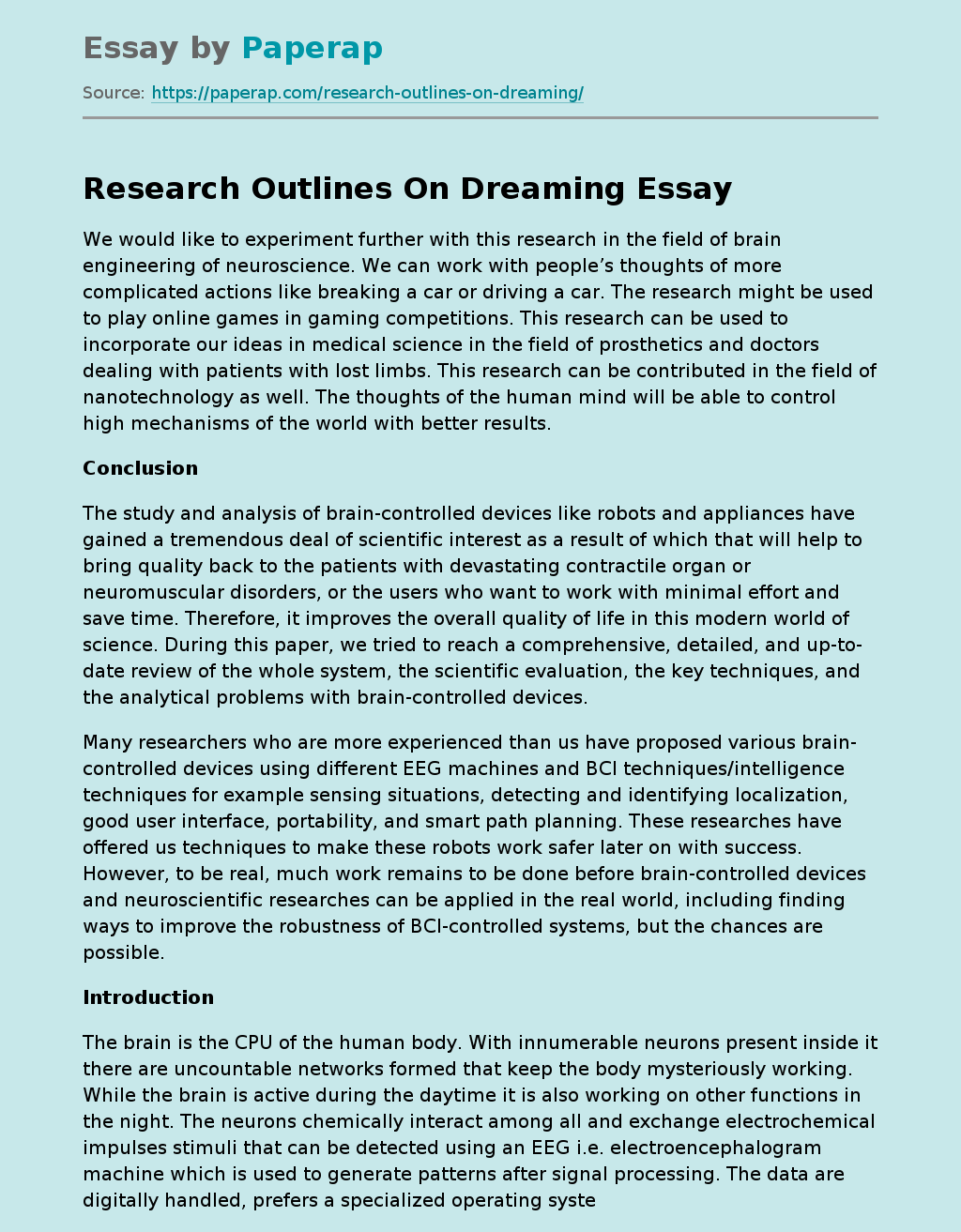Research Outlines On Dreaming
We would like to experiment further with this research in the field of brain engineering of neuroscience. We can work with people’s thoughts of more complicated actions like breaking a car or driving a car. The research might be used to play online games in gaming competitions. This research can be used to incorporate our ideas in medical science in the field of prosthetics and doctors dealing with patients with lost limbs. This research can be contributed in the field of nanotechnology as well.
The thoughts of the human mind will be able to control high mechanisms of the world with better results.
Conclusion
The study and analysis of brain-controlled devices like robots and appliances have gained a tremendous deal of scientific interest as a result of which that will help to bring quality back to the patients with devastating contractile organ or neuromuscular disorders, or the users who want to work with minimal effort and save time. Therefore, it improves the overall quality of life in this modern world of science.
During this paper, we tried to reach a comprehensive, detailed, and up-to-date review of the whole system, the scientific evaluation, the key techniques, and the analytical problems with brain-controlled devices.
Many researchers who are more experienced than us have proposed various brain-controlled devices using different EEG machines and BCI techniques/intelligence techniques for example sensing situations, detecting and identifying localization, good user interface, portability, and smart path planning. These researches have offered us techniques to make these robots work safer later on with success.
However, to be real, much work remains to be done before brain-controlled devices and neuroscientific researches can be applied in the real world, including finding ways to improve the robustness of BCI-controlled systems, but the chances are possible.
Introduction
The brain is the CPU of the human body. With innumerable neurons present inside it there are uncountable networks formed that keep the body mysteriously working. While the brain is active during the daytime it is also working on other functions in the night. The neurons chemically interact among all and exchange electrochemical impulses stimuli that can be detected using an EEG i.e. electroencephalogram machine which is used to generate patterns after signal processing. The data are digitally handled, prefers a specialized operating system, can work in real-time and are controlled by computers so hence matching with the basic traits of multimedia. It uses Raspberry pi 2 model b, a single board computer that works in real-time with a processor speed of over.
The interface used is commonly known as BCI i.e. Brain-Computer Interface. This device activates electrical, magnetic, and mechanical devices with brain signals. So far we have read about a few signals like alpha, theta, gamma, beta, etc. Many devices used are mostly headsets because we need to receive signals from the brain which are initially analog waves. Later on these are digitized and thus evaluated. Neuroscience is the branch of science that studies on the unit cells of the brain which are neurons. The sub-branch of neuroscience which is brain engineering deals with using technologies on the neurons.
Communication is at the basis of human development, making it possible to express ideologies, thoughts and on a higher level simply allow the people to lead a super well live in this earth. Individuals who are facing the consequences of the solid so-called locked-in syndrome do not have the above-stated communication (vocal, textual, body) problems. In fact, on the contrary, locked-in syndrome is caused by a tremendous amount of total loss of management over the voluntary muscles in the human body.
Core Background Study
In 1929, the invention of the electroencephalogram (EEG) by H. Berger was a revolution. He observed that contrasting states of sleep and wakefulness are associated with differences in the electrical activity of the cerebral cortex. The importance of afferent stimulation in initiating EEG and behavioral wakefulness was observed by Jasper and Rheinberger in 1937. This is the same year when A. L. Loomis et al. in England distinguished five different EEG patterns of sleep according to depth. Another step forwarded after the discovery of the relationship between rapid eye movements (REM) and the occurrence of dreams by Aserinsky et al. in 1953 was the turning point in modern dream research. After that, a simplified division of the EEG stages was suggested by Dement and Kleitman. They added to the previous classification another category, called emerging stage I or stage I REM, to which the sleepers shift whenever they show rapid eye movements. This stage is characterized by a low voltage, fast EEG pattern.
Hall and Van de Castle proposed a thorough content scoring system for dreams in 1966. It stimulated the acceleration of dream research and allowed a systematic method of studying dreams. Relationships between REM sleep and dreaming have been demonstrated with a number of other methods. Herman et al. found that rapid eye movements (REM) are produced just prior to waking up [89]. According to Valli et al., dreamed functions are physically enacted during sleep. Means, activity in the dreaming brain is similar to that of waking actions. Altogether, the study of dreams has evolved substantially since the discovery of REM sleep. Dreaming mainly occurs during REM sleep which is characterized by high-frequency electroencephalographic activity.
Albeit, dreaming also occurs in non-REM (NREM) sleep, characterized by prominent low-frequency activity. Recently some researchers successfully experimented the neural correlation of dreaming. Understanding the neural correlates of conscious experiences in sleep is the most challenging part. The presence and absence of dreaming in NREM and REM sleep were detected using high-density electroencephalography. In both NREM and REM sleep, reports of dream experience were associated with local decreases in low-frequency activity in posterior cortical regions. By analyzing that posterior ‘hot zone’ in real-time they predicted whether an individual reported dreaming or the absence of dream experiences during NREM sleep. Their prediction rate was 87% accurate.
Research Outlines On Dreaming. (2021, Dec 14). Retrieved from https://paperap.com/research-outlines-on-dreaming/

